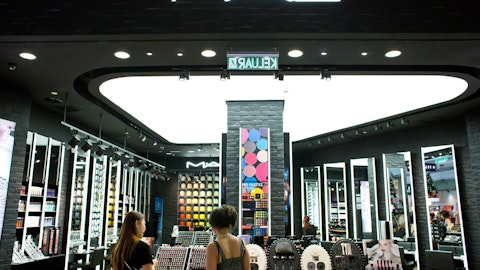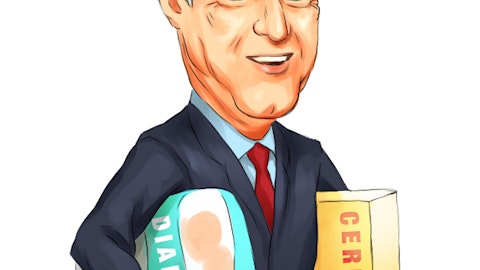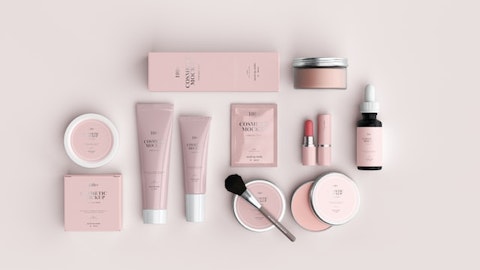Edgewell Personal Care Company (NYSE:EPC) Q1 2024 Earnings Call Transcript February 7, 2024
Edgewell Personal Care Company isn’t one of the 30 most popular stocks among hedge funds at the end of the third quarter (see the details here).
Operator: Good morning, and welcome to Edgewell Personal Care First Quarter 2024 Earnings Call. [Operator Instructions] I would now like to turn the conference over to Chris Gough. Please go ahead.
Chris Gough: Good morning, everyone, and thank you for joining us this morning for Edgewell’s first quarter fiscal year 2024 earnings call. With me this morning are Rod Little, our President and Chief Executive Officer; and Dan Sullivan, our Chief Financial Officer. Rod will kick off the call and then hand it over to Dan to discuss our results and full year fiscal 2024 outlook before we transition to Q&A. This call is being recorded and will be available for replay via our website, www.edgewell.com. During the call, we may make statements about our expectations for future plans and performance. This might include future sales, earnings, advertising and promotional spending, product launches, savings and costs related to restructuring and repositioning actions, acquisitions and integrations, changes to our working capital metrics, currency fluctuations, commodity costs, category value, future plans for return of capital to shareholders and more.
Any such statements are forward-looking statements for the purposes of the safe harbor provisions under the Private Securities Litigation Reform Act of 1995, which reflect our current views with respect to future events, plans or prospects. These statements are based on assumptions and are subject to various risks and uncertainties, including those described under the caption Risk Factors in our annual report on Form 10-K for the year ended September 30, 2023, as may be amended in our quarterly reports on Form 10-Q, which has been filed with the SEC. These risks may cause our actual results to be materially different from those expressed or implied by our forward-looking statements. We do not assume any obligation to update or revise any of these forward-looking statements to reflect new events or circumstances, except as required by law.
During this call, we will refer to certain non-GAAP financial measures. These non-GAAP measures are not prepared in accordance with generally accepted accounting principles. A reconciliation of the non-GAAP financial measures to the most directly comparable GAAP measures is shown in our press release issued earlier today, which is available at the Investor Relations section of our website. This non-GAAP information is provided as a supplement to, not as a substitute for or superior to measures of financial performance prepared in accordance with GAAP. However, management believes these non-GAAP measures provide investors with valuable information on the underlying trends of our business. With that, I’d like to turn the call over to Rod.
Rod Little: Thank you, Chris. Good morning, everyone, and thanks for joining us on our fiscal ’24 first quarter earnings call. We had a good start to the year with 3% organic net sales growth, largely driven by strong performance in international markets where mostly healthier categories and improved in-market execution drove growth. The growth was underpinned by both price and volume gains. Notably, we saw meaningful organic growth and market share gains in both Japan and Germany, reflecting both good consumer response to our brands and also a strong wholesaler and retailer support. I am very excited about the results we are seeing in our international markets as we continue to strengthen our capabilities and streamline our leadership structure across the business.
A year ago, we brought the markets closer to our global center with all non-North American markets directly reporting to me and Dan. We also made significant changes in leadership across Europe, Japan and China, which collectively represent almost two-thirds of our international business, and we’ve continued to push decision-making and accountability to the local teams, all of which has contributed to a more robust organic growth profile. In North America, despite some transitory dynamics that contributed to year-over-year organic net sales declines, most notably in fem care. Our consumption and resulting market share results were solid and largely in line with trend. Across our markets, the consumer remains resilient. Our categories remained relatively healthy and as we move into our bigger spring and summer selling seasons, we believe we are well positioned with notable innovation at Sun Care, our brand replatforming in fem care and the Billie launch into new body categories all in front of us.
Adjusted gross margin expanded year-over-year ahead of our expectations, driven by our ability to accelerate productivity savings and realize gains from improved price and revenue management. We increased investment in our brands in the quarter, remain disciplined on G&A costs and delivered adjusted EBITDA and EPS ahead of our expectations. With this good start to the year and with strong fundamentals in place, we have increased confidence in our ability to deliver our outlook for both top and bottom line. The first quarter was a good example of the business model we have built. And ultimately, our path for continued success. Solid top line growth with good market share outcomes, accelerated gross margin accretion, incremental commercial investment in support of priority brands and markets and a healthy sustainable profit profile.
Importantly, our portfolio of leading brands continues to be top of mind for consumers across the globe regardless of their preferred channels, in-store or online. In our shaving business, we are seeing the clear advantages of our manufacturing technology and improved brand building and digital capabilities with compelling innovation and stronger retailer partnerships globally, private brands market share gains and the successful retail expansion of the Billie brand here in the United States and in Canada, all demonstrating clear proof points of a healthier shave portfolio. In Sun Care, the mid-single-digit organic growth in the quarter was in line with expectations, and we saw good execution from concept to shelf across our leading portfolio of trusted brands.
Our end-to-end capabilities of product formulation, regulatory, quality control, internal manufacturing and direct store delivery to shelf are all points of competitive advantage that contribute to our broader success. Our Grooming portfolio of well-crafted brands continues to resonate with consumers and will soon be augmented by the disruptive force of the Billie brand as we begin to execute our retail pilot and the initial launch of the brand’s offering embody beginning today. And finally, in fem care, we believe that we’ve now cycled through the supply chain and demand imbalances that have plugged the category over the last 18 months and make year-over-year comparisons challenging. I’m personally bullish about the opportunities that our new master brand strategy offers, as we replatform our pads and liners business under the Carefree brand with a unique consumer positioning and a motive campaign that I expect will resonate well with our target consumers.
Our brands are healthier and once again this year better represented across all channels of distribution than at any point since we began as an independent company in 2015. The initial read on distribution outcomes for 2024 is encouraging, all of which underpins our durable, sustainable top line growth profile this fiscal year and beyond. Operationally, we remain disciplined in the face of continued, though easing inflationary headwinds. We generated almost 600 basis points of combined gross margin benefits from productivity and efficiency initiatives as well as price and revenue management execution. Our teams did a terrific job in the quarter of driving operational excellence across the supply chain, while further realizing the benefits of our focus on unit economics and sound revenue and promotion management.
And importantly, as planned, we increased investment in support of our brands with spend centered around digital activation ahead of the compelling innovation that will come to market later this quarter. So to wrap up, the results this quarter and our outlook for the full year illustrate the progress we’ve made since outlining our long-term vision and growth goals in 2020 and importantly, demonstrate that our strategy is working. As we move past peak inflationary pressures that have — we have contended with for the past two years, we remain confident in our financial model, which calls for organic net sales growth, gross margin accretion, G&A leverage and strong free cash flow generation. Simply put, our business is better through the stronger portfolio of brands and a demonstrated ability to successfully execute against each of our key strategic priorities.

This gives us confidence that we will deliver significant value creation for our shareholders. And now I’d like to ask Dan to take you through our first quarter results and discuss our outlook for fiscal ’24. Dan?
Dan Sullivan: Thank you, Rod. Good morning, everyone. As Rod mentioned, operational and commercial execution in the quarter was strong, particularly in our international markets, which helped drive solid top line growth, good market share results and notable gross margin accretion, all of which enabled better-than-expected earnings and cash generation for the quarter, while setting us up well to deliver full year results in line with our previous outlook. For the quarter, organic net sales grew 3.1%, largely driven by higher pricing. International organic growth was just over 16%, underpinned by both price and volume gains. In the quarter, the consumer remained resilient with our categories in aggregate continuing to grow and signs of structural recovery in key international markets like Japan and Germany.
Aggregate consumption across our U.S. segment increased 2.2% in the quarter, below 52-week trends as gains from pricing eased compared to a year ago. Importantly, volume consumption remained strong in both Women’s Shave and Grooming, where we gained and held volume share, respectively. Operationally, our teams continue to execute. The supply chain organization further improved service levels and unit fill rates, while realizing better-than-expected productivity savings. And our commercial teams drove strong gains from both price and promotion management. In total, these efforts combined to provide almost 600 basis points of gross margin tailwinds in the quarter, which nearly offset the transitory unfavorable effects of lower manufacturing absorption and the negative effect of heightened unit cost inflation trapped in inventory, both of which we previewed last quarter.
Despite these significant onetime headwinds, we delivered 30 basis points of adjusted gross margin accretion, adjusted EPS of $0.24 per share and adjusted EBITDA of $57.2 million, all of which were above our expectations. Now let me turn to the detailed results for the quarter. As mentioned, organic net sales increased 3.1%, driven by strong performance across international markets, all of which grew year-over-year. The strong international performance was a result of nearly double-digit volume growth, coupled with mid-single-digit price related gains. Performance in Japan was a highlight as a return to healthy category consumption was met with strong price execution and a favorable pull forward of purchases ahead of the New Year holiday. Organic sales in North America were down 4.9%, more than half of which was attributable to declines in fem care as we cycled double-digit organic growth last year.
North America volumes were down just over 6%, while pricing delivered over 1 point of growth. Wet Shave organic net sales were up 8.1% and with growth across Men’s and Women’s Systems, Disposables and Preps. International Wet Shave growth stood out in the quarter at 18% as a result of improved market conditions, strong in-market brand activation, higher pricing and the aforementioned replenishment phasing benefits in Japan. In the quarter, we saw meaningful market share gains in Japan, Germany and Canada. Wet Shave organic sales in North America declined 2% with declines in both disposables and preps more than offsetting a strong quarter for Men’s Systems. In the U.S. razors and blades category, consumption was flat in the quarter, and our market share increased 10 basis points, driven by share gains in branded Women’s Systems as Billie continue to scale at retail while also growing in newly activated online channels.
In the quarter, the brand reached a 14 share at Walmart and a 7 share on Amazon. And the most recent scanner data is now the number 3 brand in the set at Target and CVS. Despite the heightened competitive environment within the women’s category, our branded volume share gains of 210 basis points were above recent track. Men’s Systems and Disposables market shares were essentially flat in the quarter. Sun and Skin Care organic net sales increased about 1% as mid-single-digit growth in Sun Care was partially offset by declines in North America grooming and skin. North America Sun Care growth was over 5% and driven by higher volumes. International Sun Care sales increased just over 5% as well despite cycling almost 70% growth last year, driven primarily by higher pricing.
In the U.S., the Sun Care category was up approximately 8%, and our share was essentially flat. Grooming organic net sales decreased 2.6% as Bulldog growth in Europe was more than offset by declines in CREMO in the U.S. as we cycle certain MDD launches a year ago. Wet One’s organic net sales declined 1.3% and our share grew to approximately 77%. Fem care organic net sales were down 11.2% for the quarter, primarily reflecting lower volumes. Consumption in the category was up 1.5% or half the rate of the previous 52 weeks, and our share of the market declined 1 point. In the quarter, we cycled competitive out of stocks a year ago and felt the impact of retailer inventory buydowns in part a result of the Carefree master brand launch happening later in the spring.
However, increased promotional intensity in the tampons category as competition returned to shelf and the magnitude of the retailer destocking caused a higher-than-expected drag on organic sales and share performance in the quarter. Now moving down the P&L. Gross margin rate on an adjusted basis increased 30 basis points, inclusive of 70 basis points of favorable currency. Approximately 380 basis points of productivity savings and 210 basis points of price gains, partially offset 520 basis points of transitory cost headwinds related to unfavorable absorption and heightened unit cost inflation trapped in inventory. Core gross inflation pressures of about 70 basis points and 40 basis points of negative mix and other items. A&P expenses were 9.9% of net sales, 10 basis points higher than the prior year.
Adjusted SG&A increased 110 basis points in rate of sale versus last year as higher incentive compensation and people-related costs and the impact of unfavorable currency movements were only partly offset by savings realized from ongoing operational efficiency programs and sales leverage. Adjusted operating income was $35.7 million compared to $37.3 million last year, a decrease of approximately 4%. GAAP diluted net earnings per share were $0.09 compared to $0.24 in the first quarter of fiscal ’23 and adjusted earnings per share were $0.24 compared to $0.32 in the prior year period. Currency movements had no material impact on adjusted earnings per share as currency benefits within operating profit were offset by lower hedge gains within other income and expense.
Adjusted EBITDA was $57.2 million compared to $64.5 million in the prior year. Net cash used from operating activities for the quarter was $72.9 million compared to $86.3 million in the prior year period. We ended the quarter with $214 million in cash on hand, access to the $207 million undrawn portion of our credit facility and a net debt leverage ratio of 3.8x. In the quarter, share repurchases totaled $15 million, and we continued our quarterly dividend payout and declared another cash dividend of $0.15 per share for the first quarter. In total, we returned nearly $23 million to shareholders during the quarter. Now turning to our outlook for fiscal 2024. As Rod mentioned earlier, with a good start to the fiscal year and strong fundamentals in place, we have increased confidence in our ability to meet our previously provided outlook, which reflects sustainable top line growth, gross margin accretion and double-digit constant currency adjusted EPS growth.
The macro environment remains challenging with an uncertain geopolitical and economic backdrop, potential risks from further supply chain disruptions and a lack of clarity around the durability of the consumer resiliency that we have seen thus far. And while FX remains volatile, our assumption for currency impacts to the full fiscal year is unchanged from our prior outlook. For the fiscal year, we still anticipate organic net sales growth in the 2% to 4% range. Our outlook for gross margin accretion is unchanged as we continue to anticipate an increase of approximately 80 basis points or 100 basis points at constant currency. There is no change to our full year view for the elements that underpin our gross margin profile, including inflationary headwinds, productivity savings, pricing and FX.
Adjusted EBITDA is still expected to be in the range of $340 million to $352 million. Adjusted EPS is still expected to be in the range of $2.65 to $2.85, inclusive of approximately $0.20 per share of currency headwinds. In terms of phasing, we continue to expect similar organic sales growth rates between half one and half two, and we now expect 35% of our full year EPS in half one and 65% in half two. For more information related to our fiscal 2024 outlook, I would refer you to the press release that we issued earlier this morning. And now I’d like to return the call to the operator for the Q&A session.
See also 20 Dating Sites with the Most Users in 2024 and 11 Best Gold Stocks For Inflation.
Q&A Session
Follow Edgewell Personal Care Co (NYSE:EPC)
Follow Edgewell Personal Care Co (NYSE:EPC)
Operator: [Operator Instructions] The first question is from Nik Modi with RBC Capital Markets. Please go ahead.
Nik Modi: Thanks. Good morning, everyone. Just a quick clarification, Dan, if you don’t mind. Just obviously, a pretty good result on earnings relative to kind of where I think most people were and you held the guidance. Is that just because of the pull forward in Japan? I just want to make sure I just understand exactly what’s going on just from a cadence perspective. And then the broader question is just, obviously, international, 50% of your business, you have a lot of change. What inning are we in, in terms of like the full foundation being set from some of your new operators in those markets and the new reporting structure? Just to understand kind of how much more progress you can actually make in that market.
Dan Sullivan: Hi, good morning Nik, thanks for the question. I’ll take them in reverse order. I’ll start with international because you’re right, we’ve been on this journey now for a little over a year. Rod alluded to it in his prepared remarks. So the first thing we did was bring the markets closer to us and changed the reporting lines, eliminating a layer within the previous international leadership team and essentially bring that business closer to the management table here in the U.S. The second step is we’ve made meaningful leadership changes across three really important markets, China, Japan and Europe. That was about a year ago as well. What you’re seeing now is a combination of those effects, new strategies that have been developed and are being executed and they’re playing out differently in each market, right?
You’ve got the changes we made in wholesaler and wholesaler inventory in Japan a year ago. We’ve got a new organization in Europe with a new strategy. And so I think there’s a lot of really good things happening. If I had to peg it, I would say we’re in the middle innings. We like what we’ve done over the last year to 18 months. But certainly, you’re bullish on continued upside across all of our international business. Before I go on, Rod, anything you would add to that?
Rod Little: Yes. I think, Nik, Dan has captured it well. What I would double-click on though is the importance of leadership, having the right local leadership that’s fit to win, capable to win locally. And we’ve done that now in the key markets, not only with the leaders themselves, but building out much more capable teams below them. I won’t mention the market by name, but we have one market where we have an entirely new leadership team in place that’s now been in place for over a year. We’re starting to see the fruits of that. The final thing I’ll mention relative to international is there’s a big opportunity from here. And I think this is the back end innings part of what’s to come to have our innovation be fit for purpose for more local Asian and European markets as opposed to exporting U.S. ideas or innovating towards a global consumer that frankly doesn’t exist. And so I think that’s to come as we look towards ’25 and ’26, we remain bullish on international.
Dan Sullivan: Yes. And then, Nik, just to pick up the question on holding on the outlook. I think there’s a couple of points I would make. One, what we were really encouraged by in the quarter was the gross margin profile. Some of that is timing and phasing of what we have pulled forward into the quarter that we had phased for later in the year. That’s just a reality. I think the general sentiment though is we’re one quarter in. We haven’t yet gotten into the sun season in the U.S., which we all know what that can mean for our business. And so we’re just being prudent here about where we are in the year, what line of sight we have. We’re confident. We feel really good with the start of the year and some of the underlying execution. But given the business that lies ahead of us, particularly in Sun, we obviously chose to hold the guidance.
Nik Modi: Makes total sense. Thanks, guys. I’ll pass it on.
Rod Little: Thank you, Nick. Operator, next question, please.
Operator: The next question is from Olivia Tong with Raymond James. Please go ahead.
Olivia Tong: Great. Thanks. Good morning. I wanted to understand a little bit about what came in better than expected on the expense line since those — you were pretty clear on the guide for this quarter, sort of giving us caution around some of the inventory and some of the SG&A sort of being more in line with Q2 and Q3 of last year. So what sort of worked better than you thought? And as you think about — you just sort of de facto gave us guide for Q2, which would suggest that in order to sort of say in the range of Q3 and Q4 have to come in a little bit. Just talk a little bit about the puts and takes there, if you wouldn’t mind? Thank you.
Dan Sullivan: Yes, good morning, Olivia. Sure. Look, I think the surprise, if you will, in Q1 was all in the margin profile, and it was obviously a good surprise, but it was the reflection of really good execution by the team on both the cost side of the ledger. So productivity worked harder for us and delivered more than we had expected. And on the revenue side, both in price and what we call SRGM. And I think there’s sort of three factors that I would point to, and I’ll kind of tick through them in order of magnitude, recognizing all three carry with them, some phasing benefit that doesn’t necessarily change the year but certainly was a benefit in the quarter. As I mentioned, the first item is productivity. The team did an excellent job on execution.
They accelerated certain initiatives that we had faced later in our plans and really are executing at a high level. I think what was a bit of a surprise, which is timing in the quarter is where global procurement was able to land certain global contracts, rebate programs and settlements that we had planned for later in the year that hit us in the quarter in a good way, but really good execution. I think the second thing I would point to is mix. Anytime you see this level of growth in Shave, right? We grew Wet Shave over 8% in the quarter and particularly internationally in Japan, where we had price increases attached to it, you’ve got a mix benefit for the business. That is all entirely timing for us. And then the third piece is warehouse and distribution costs, which is a little bit of both.
I think really good structural execution. We are seeing rates come down. We are seeing inflation easing. We also shipped heavy. We’re very productive in our shipments in terms of full truckloads. So I put all that together, I would say to you, the 200 basis point margin accretion in the quarter was more than we had profiled and I would say roughly 75% of that is likely timing, 25% of that is structural. That was really what we saw in the quarter. On the expense lines, G&A, A&P and otherwise, as we mentioned also in FX, lined up pretty much what we had expected.
Olivia Tong: Great. And just following up on advertising. Obviously, advertising plus or minus flattish this quarter. The guide would suggest that there’s more of an increase as the year progresses. Can you talk about the categories in particular that you expect to see really ramp up with respect to the advertising?
Rod Little: Good morning. Yes. Olivia, Rod here. We have the bulk of our innovation program for the year to come is in front of us. We talked about Billie Body launching actually yesterday and today as we’ve launched into brick-and-mortar and online with a new line of body products that we’re very excited about. So that will be a net increase in investments in advertising and support behind that. We have what we believe is the number 1 innovation, the biggest and most disruptive innovation in Sun Care coming this year on Banana Boat, 360 coverage missed. It’s an alternative spray product for those that like sea sprays. They’re typically propellent driven, not great for the environment. This is a sustainable, nonpropellent driven spray.
It’s, we believe, a superior spray formulation. It’s exclusive on Banana Boat. Beyond all the other innovation we have coming on Sun Care, that’s the number 1 thing that comes see us start to ramp up investment behind that as we come into the big spring and summer months. And the final piece is a carefree master brand replatforming where we have a major product upgrade coming on our Carefree pads business, less plastic, more sustainable, more absorbent. We have a major simplification as part of that, where we’re collapsing the Stayfree brand under Carefree. So effectively going two brands into one with very strong retailer support and absolute clarity on the target for that new branded positioning. It’s moms, and we’ve got a very motive campaign that we’re going to put in place and spending to drive that brand.
So that’s all still to come and that’s why I think you’ll see coming in Q2 through the balance of the year.
Olivia Tong: Great. Thank you. Best of luck.




